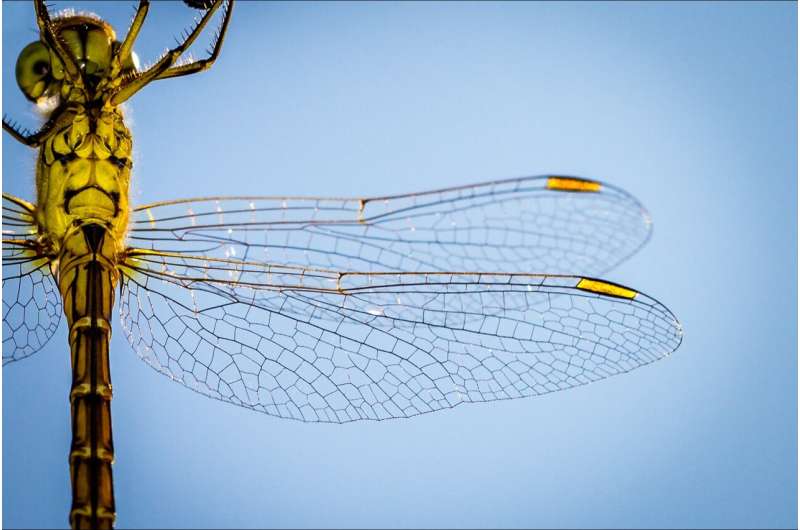This article has been reviewed according to Science X's editorial process and policies. Editors have highlighted the following attributes while ensuring the content's credibility:
fact-checked
peer-reviewed publication
trusted source
proofread
Using dragonfly wings to redesign a Boeing 777 to be lighter, stronger and more sustainable

Throughout history, humans have observed and sought inspiration from many aspects of nature to improve flight efficiency, maneuverability, and stability. And since the days of Leonardo da Vinci, nature-inspired design, also known as biomimicry or bio-inspired design, has played and continues to play a significant role in the development of aviation.
Now, in a paper published in Advanced Science, Masoud Akbarzadeh of the Weitzman School of Design at the University of Pennsylvania and his former Ph.D. student Hao Zheng build upon the principles of biomimicry by drawing inspiration from the wing of a dragonfly to redesign that of a Boeing 777.
Why a dragonfly?
"Nature's a great teacher in telling us how to optimize systems," Akbarzadeh says. "And when you look at a dragonfly, you see wings that have evolved over millions of years into an incredibly lightweight, efficient, and strong structure."
He explains that he and his team were interested in the geometry of the surface and internal structure of veins on the wings. He says the intricate hierarchical configuration of the wing provides strength and flexibility and allows dragonflies to generate lift and maneuver swiftly.
"When we looked closely at the patterns on a dragonfly's wing, we realized that it includes many convex polygons," Akbarzadeh says.
"The convex network of the wing is very similar to the efficient networks we design using the method of graphic statics that we research and develop in the lab," he says. "We thought, 'could we use our geometry-based analysis tools to analyze these patterns and recreate them under different conditions for other types of wings?'"
Dissecting the wing
The researchers analyzed the intricacies of the dragonfly wing's geometric vein network by employing a methodology proposed by James Clerk Maxwell in 1864 called Maxwell's reciprocal diagrams. This analysis tool, used to calculate the equilibrium of forces in a system, played a significant role in decoding the physics of the dragonfly wing structure.
"There was a correlation between the thickness of the connected constituent components, or members, and the in-plane equilibrium of that network," Akbarzadeh says. "In simpler terms, it's like taking the dragonfly's vascular network, pulling it from all sides, and finding that the overall structure works perfectly as a tensile network, at least on a 2D plane."
"This was shocking," he says, "because the wing is designed for bending behavior associated with flapping movements rather than a tension-only or compression-only network."
This finding enabled the researchers to investigate the behavior of wing structure mimicked by the wing's structural pattern. "Eventually, we showed that this approach could result in more efficient wing structures against out-of-plane bending," Akbarzadeh says.
Machine-learning from nature
The team partitioned the wing's geometry into the internal vascular network and outer edges. With that, they were able to map out how the internal structures within the dragonfly's wing could be affected by the other components.
"We used the form and force diagrams of the dragonfly wing as a training data set to develop our machine learning model that could generate structural networks that closely mirrored the actual geometry of the wing," Akbarzadeh says.
The finding provided valuable data for training their machine-learning algorithm.
"Imagine an airplane wing designed following the principles observed in a dragonfly wing," Akbarzadeh says. "By doing so, we could potentially create lighter, more efficient airplanes, using fewer materials, leading to considerable savings in fuel and costs, not to mention a substantial reduction in aviation's environmental footprint."
Transforming theory into reality
The team members applied their finding to real-world scenarios by incorporating dragonfly-inspired designs into a 2D extruded airframe of a Boeing 777 wing at a 1:120 scale and observed a significant improvement in the structural efficiency of the wings.
The dragonfly design enhanced the out-of-plane stiffness by an astonishing 25%, suggesting the potential for lighter and more efficient wing designs.
"This not only affirms the practicality of the research but also offers a tantalizing glimpse into the future of aviation," says Akbarzadeh.
Soaring into the future
Looking ahead, the team plans to dig deeper into the 3D structure of the dragonfly wing, hoping to uncover further design inspirations. They also anticipate refining their machine learning model, enhancing its predictive capabilities, and increasing the accuracy of the artificial structure's recreation.
"This study shines a spotlight on the untapped potential of nature-inspired design," Akbarzadeh says. "Through the synergistic fusion of machine learning, structural biology, and engineering, a new frontier is emerging, one that promises a wave of innovation across various engineering disciplines."
"As we continue to peer into the intricate structures of the natural world for inspiration, who knows what other secrets we might unlock? From dragonflies to other winged animals, our journey of discovery is just beginning."
More information: Hao Zheng et al, Dragonfly‐Inspired Wing Design Enabled by Machine Learning and Maxwell's Reciprocal Diagrams, Advanced Science (2023). DOI: 10.1002/advs.202370111



















